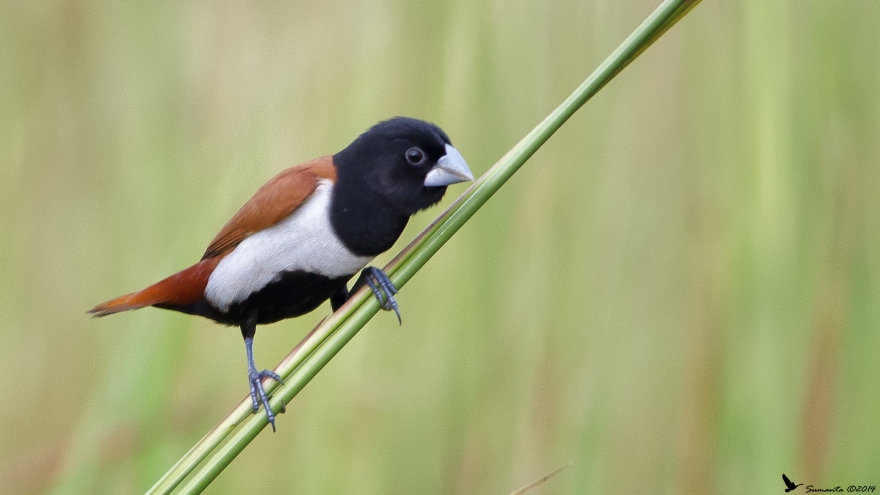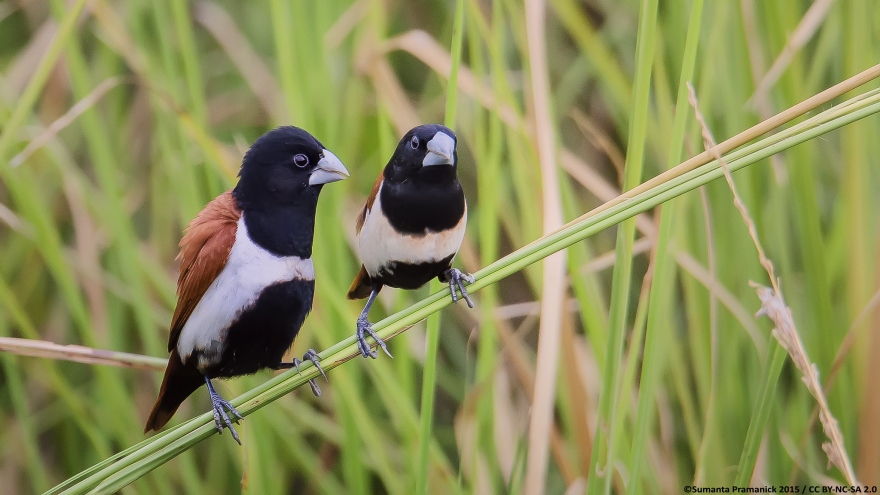The tricoloured munia—also known as the tri coloured nun—is a small finch found in India, Bangladesh, Pakistan, and China. They have also been introduced to the Carribean.
Their striking colouration and low care requirements have made them a popular bird in aviculture. In Australia, they are readily available but remain less popular than the closely-related chestnut-breasted mannikin.

Housing & Compatibility
Tricoloured munias can be housed successfully as single pairs, a small colony, or as part of a mixed collection. They prefer a large planted aviary, but can tolerate a smaller aviary or flight cage.
They can be successfully housed with most placid finches, quail, doves, and (space permitting) Neophema parrots. They enjoy being part of a flock of their own kind if space permits.
Tricoloured munia should not be housed with any species with which they can hybridize, which includes all mannikins and munia species in the Lonchura family.
Diet & Feeding
A quality seed mix including canary seed, various millets and panicum forms the basis of the tricoloured munia’s diet. Seed lacks many essential vitamins and minerals which must be compensated for by introducing other foods. Sprouted seed increases the nutritional value of seed and is a cheap way to improve your birds health. Freshly grown green seed heads should also be offered frequently.
Leafy greens should be provided throughout the year. Kale, bok choy, endive and silverbeet are the most nutritious and will be readily eaten. Spinach can also be given, but only sparingly as it can contribute to calcium deficiency. Small quantities of fruit, such as apple and pear, is sometimes appreciated by tricoloured munias.
Live food is an inessential but valuable component of the tricoloured munia’s diet during the breeding season. Mealworms, maggots, termites, and small crickets are popular choices that are generally easy to source. Commercial soft finch food mixes can also be provided for an added nutrient boost. Outside of the breeding season their live food requirements are quite low.
Do not feed anything from the list of forbidden foods.

Breeding
Tricoloured munias breed best in spring and autumn, with a hen bird that is at least 12 months of age. Best breeding results are usually achieved in the second year of breeding.
A wide variety of artificial nests will be accepted, though they have a preference for dense brush well above ground level. They will construct a spherical nest from fine strands of dry grass. The nest will often be refurbished and re-used for subsequent clutches, so make sure new nesting material is always available.
They typically lay 4-7 eggs in each clutch, which are incubated by both parents for about two weeks. Nest inspections are generally tolerated, however some pairs may be sensitive to disruptions and abandon the nest, so it’s generally best to avoid inspections if possible.
Young birds fledge the nest at three weeks of age and are usually independent a month later. It’s generally safe to leave them in the same aviary as their parents, but make sure you’re using leg rings to tell them apart as they age.
When conditions are good, they can be prolific breeders, producing up to four clutches per year. Hen should be discouraged from breeding beyond 3-4 clutches per year, as overbreeding can lead to a shortened lifespan and smaller, poorer quality chicks.
Sexing
Tricoloured munias are sexually monomorphic, meaning males and females look virtually identical. DNA sexing is the only reliable to accurately determine the gender of an individual bird.
It is thought that tricoloured munias’s can be sexed by observing the lower mandible of their beak, which is supposedly slightly larger on males than females.
Mutations
No mutations have been established.
Health
A strict worming and parasite control regime is essential to ensure the long-term health of any finch collection. Tricoloured munias, when properly cared for, can be expected to live for 7-8 years.
What is the best way for worming control and parasite control??